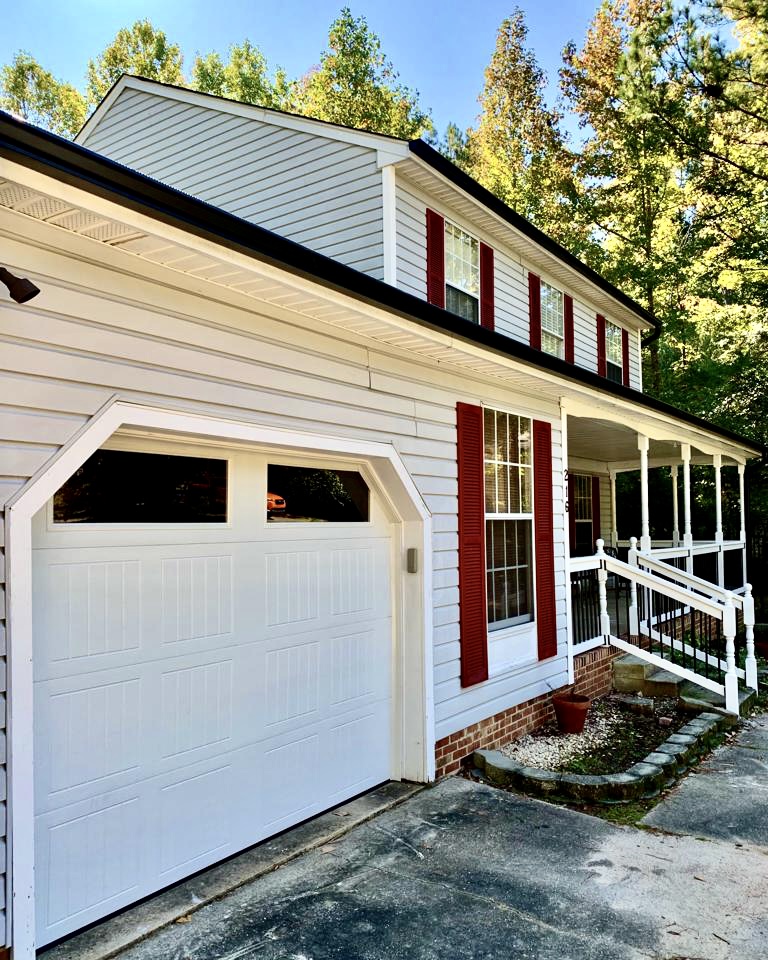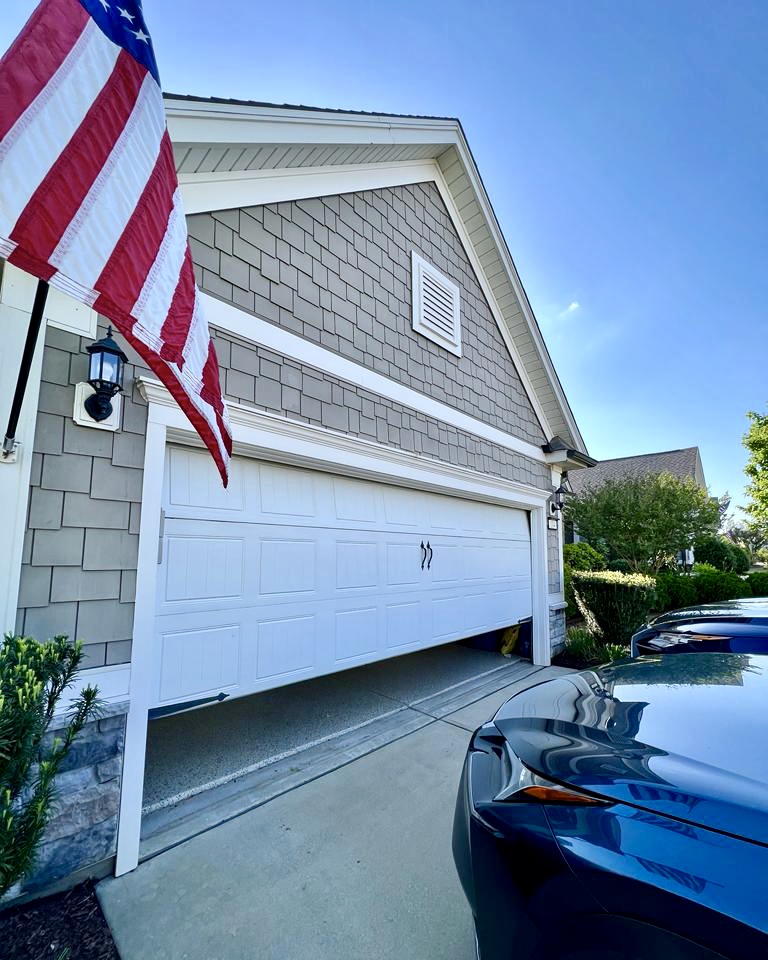With climate change leading to increases in extreme weather events across many regions, it’s important for homeowners to understand how these weather conditions can impact garage doors and what preparations to take. Damage from heavy rain, wind storms, extreme heat and cold can disrupt garage access and require expensive repairs if not properly addressed. This article explores the effects different extreme weather has on garage doors, preventative measures to protect them, and what to do if damage occurs.
How Moisture and Flooding Affects Garage Doors
Excess moisture is one of the biggest threats to garage door integrity and functionality. During heavy rains or flooding, moisture causes the following issues:
- Wood Warping and Rotting – Wood garage doors absorb excess water, causing the wood to swell, warp, and rot over time. This not only damages a door’s appearance but compromises its structural stability and sealing ability.
- Rust and Corrosion – Wet, humid conditions corrode and rust metal fixtures like hinges, tracks, bolts and moving parts. This can jam and disable the opening/closing mechanism over time. Rust also spreads, weakening structural integrity.
- Motor Short Circuiting – Flooding can short circuit and fry opener motor if water reaches electrical components. Replacing an opener motor is expensive.
- Compromised Seals/Weather-stripping – Excess moisture causes seals and weatherstripping around the garage door perimeter to expand and contract. This deterioration allows air, debris and additional moisture to enter the garage space.
To limit moisture damage, ensure proper grading and drainage away from the garage, clear debris, repair cracks in concrete and use topical sealants on wood doors.
Wind Storm Effects on Garage Doors
High winds during storms can wreak havoc on garage doors via:
- Blown In Doors – Wind gusts exert extreme pressure on doors, blowing them inward and damaging hinges and paneling. This also allows wind and rain inside the garage.
- Debris Damage – Storm winds propel all types of debris that dent and puncture door exteriors. Tree limbs, gravel and airborne projectiles can cause severe collisions.
- Off-Track Doors – Powerful winds can disengage a door from its track, damaging rollers and hardware. The detached, free-swinging door can destroy vehicles and interior walls.
- Disabled Electric Openers – Storm-related power outages disable motorized openers, preventing access. Winds can also detach opener arms from doors if not reinforced.
Protecting doors from wind involves removing nearby debris, trimming overhanging trees/vegetation, installing vertical and horizontal reinforcement bars, and using heavy-duty weatherstripping. Garage door wind load specifications help determine adequate storm resistance.
Effects of Temperature Extremes on Garage Doors
Shifts to extreme heat and cold, often in shorter periods, also damage garage doors via:
- Material Expansion/Contraction – Wood swells and shrinks, cracking panels, loosening hardware, and testing structural integrity. Metal and vinyl contract and expand as well.
- Desiccation – Heat and UV rays dry out and accelerate wear of rubber seals, weather-stripping, opener drive belts and other materials which harden and split.
- Opener Overheating – Heat buildup causes opener motors to overheat and malfunction. Direct sunlight on metal doors transmits further warmth.
- Frozen Moisture Distortion – Freezing precipitation enters crack and crevices, accumulating and expanding inside the door. This exceptional pressure jams mechanisms.
To regulate temperature flux, insulate doors properly, use durable seals/weatherstripping materials, install sun shields and protect openers from direct heat/cold. Perform frequent maintenance checks before extreme weather arrives.

Preventing Weather Damage Through Maintenance
While extreme weather can damage garage doors in many ways, homeowners can protect them significantly through regular preventative maintenance:
- Check Door Balance – Ensure electric opener properly balances and lifts the door without straining. Doors too light or heavy cause mechanical issues over time.
- Inspect Fixtures/Panels – Check rollers, hinges, cables and door panels for any cracks, loosening or wear quarterly. Tighten hardware and replace damaged parts.
- Lubricate Components – Apply liquid lubricant to all moving metal components including rollers, torsion springs, bearing plates and hinges. This prevents rust/binding.
- Seal Perimeter – Look for any cracking, shrinking or gaps around the door perimeter seals which allow air/moisture entry. Replace seals at first sign of wear.
- Address Rust Spread – Use wire brush to remove rust then prime/paint metal fixtures to protect underlying metal and prevent spreading.
Being diligent with these preventative garage door maintenance practices goes a long way toward enduring extreme weather. Check and service them seasonally as weather patterns shift.
What To Do If Your Garage Door Sustains Damage
If extreme weather damages your garage door:
- Assess Damage Severity – Determine if full door replacement needed or if repairing/replacing individual damaged components like panels, rollers, cables will suffice.
- Consult Technician if Major Damage – If door no longer aligned, closing properly or opener/motor shows problems, contact a Professional garage door technician to diagnose issues and recommend fixes.
- Contact Insurance Provider – If covered under homeowners insurance, file claim and provide necessary documentation on damage causes and contractor estimates. This often includes pictures.
- DIY Minor Fixes if Applicable – Minor issues like opener arm detachment, debris clearance or loose hardware can often be fixed with some mechanical knowledge. However, be cautious of torsion spring systems which store dangerous tension. YouTube tutorials can guide you through basic repairs.

With some diligence on protecting it from extreme weather and attentiveness to fixing any damage that does occur, a well-maintained garage door will guard your home and vehicles for years to come. Regular inspection and upkeep is crucial with climate change impacting weather patterns. Prepare your garage door for extreme weather before it arrives.
Conclusion
As extreme weather events increase across the country, homeowners must take proactive steps to protect garage doors from heavy rain, high winds, rapid temperature swings and moisture damage. Performing regular maintenance and inspection for signs of initial wear helps prevent costly repairs down the road. Weatherproofing the garage interior and installing reinforcements provides further stability when extreme weather hits. Being informed on how temperature fluctuations, storms systems and flooding can impact garage doors allows taking the right preparatory and reactive measures. With proper care, your garage door can withstand most weather conditions. Protect this vital home access point from nature’s intensifying fury.
How often should I maintain and lubricate the components of my garage door?
Industry experts recommend lubricating, inspecting for damage, testing electric openers and examining weather seals/perimeter seals quarterly at a minimum. Monthly checks ensure optimal function and allow catching small issues before they worsen.
During power outages, is it safe to disengage the electric opener and manually open/close the door?
Yes – most garage doors have quick-release mechanisms allowing them to separate from automatic openers. This allows manually moving while the motor lacks power. But use caution, only lift what you can handle and ensure door properly realigned when power/opener restored.
What type of reinforcement bars help a garage door withstand high wind gusts during storms?
Horizontal and vertical reinforcement struts anchored firmly into the concrete floor and ceiling rafters provide critical additional structural support during high winds. Installing these triangular bracings in the interior garage prevent the door from detaching or caving inward.
Why does my garage door make a loud cracking/popping noise when I operate it in below freezing temperatures?
The contraction of extremely cold temperatures can cause garage door materials like steel, wood and vinyl to shrink at different rates. This shrinkage misaligns track hardware and loosens hardware, allowing components to bind or stick during operation, producing noises.




